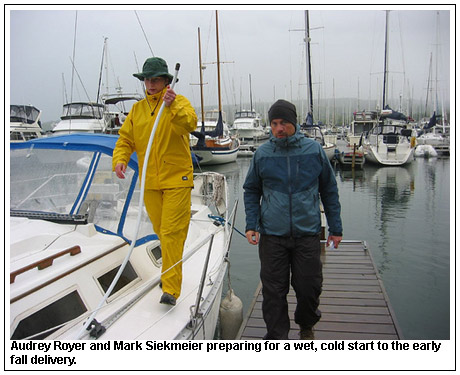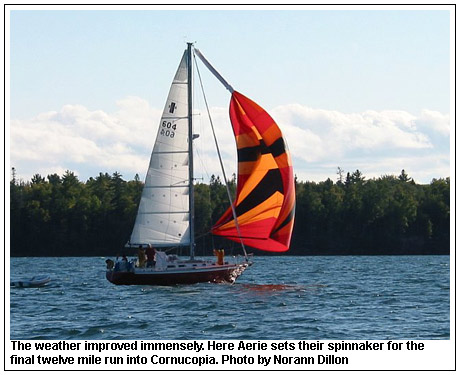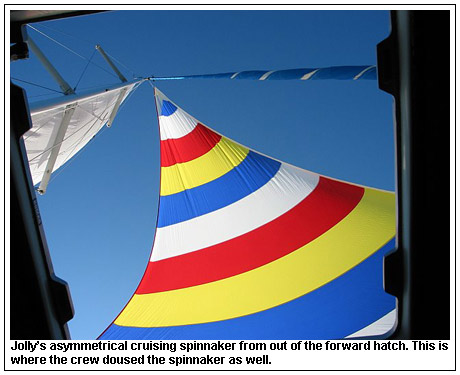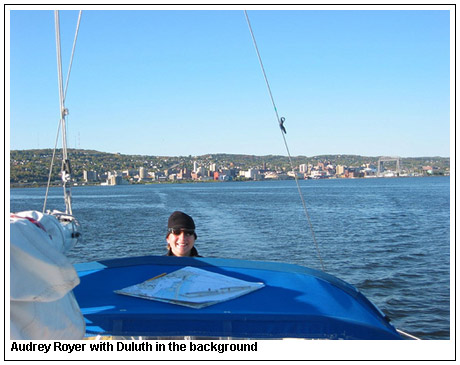|
Northern Breezes, We Deliver
by Tony Green
 It was an early October sailing trip on southern Lake Superior. Northern
Breezes Sailing School had finished up the year's classes the previous week and the upcoming weekend was the Bayfield Apple Festival, the unofficial end of the
tourist season on this part of the lake. October weather can be unpredictable anywhere, but on Superior it can be downright mean. Previous years have
brought snow and sleet in early fall and Captain Thom Burns had two of the school's boats, Aerie and Jolly Swagman, to move to Duluth, Minnesota from their
summer home in Bayfield, Wisconsin. Aerie, an Islander 36, and Jolly, a Hunter 34, would spend the winter at Spirit Lake Marina outside Duluth for the simple reason
that they would be much closer to the school's office in Minneapolis. Driving time to Duluth for fall and spring maintenance is about half of the 4.5 hours it
takes to get to Bayfield, a significant round-trip time savings. The downside was that the two yachts had to be moved about 80 miles down the Lake Superior
shore, with only two harbors of refuge, Cornucopia and Port Wing, as bail-out spots in case the weather turned ugly. Clearly, Captain Thom would need help
and that's where we came in.
It was an early October sailing trip on southern Lake Superior. Northern
Breezes Sailing School had finished up the year's classes the previous week and the upcoming weekend was the Bayfield Apple Festival, the unofficial end of the
tourist season on this part of the lake. October weather can be unpredictable anywhere, but on Superior it can be downright mean. Previous years have
brought snow and sleet in early fall and Captain Thom Burns had two of the school's boats, Aerie and Jolly Swagman, to move to Duluth, Minnesota from their
summer home in Bayfield, Wisconsin. Aerie, an Islander 36, and Jolly, a Hunter 34, would spend the winter at Spirit Lake Marina outside Duluth for the simple reason
that they would be much closer to the school's office in Minneapolis. Driving time to Duluth for fall and spring maintenance is about half of the 4.5 hours it
takes to get to Bayfield, a significant round-trip time savings. The downside was that the two yachts had to be moved about 80 miles down the Lake Superior
shore, with only two harbors of refuge, Cornucopia and Port Wing, as bail-out spots in case the weather turned ugly. Clearly, Captain Thom would need help
and that's where we came in.
 "We" were a handpicked crew of Northern Breezes instructors and graduates
solicited to help in the delivery. Well, not exactly handpicked; we were actually the first ones to respond
to Thom's e-mail request. Of course, he had veto power to eliminate incompetent and/or disagreeable sailors, but it pretty much was first-come, firstserved. This was unpaid work
with strangers over two weekdays in potentially unpleasant weather, but amazingly, Thom usually has to turn people away. Most of us came for the same reason: a chance to sail on
Superior and do something new on the water. There's just something about the big lake that makes sailors volunteer for this sort of stuff. There were ten humans and one canine on the
trip. Thom, his wife Michele and dog Dewey led the crew on Aerie, with Paul Maravelas and Tim Black, both Northern Breezes instructors, as crew. Audrey Royer, also an instructor, skippered Jolly, with a crew consisting of
myself and Scott Sandberg, both freshman ASA instructors, and Norann Dillon, Mark Siekmeier and Lou Culbert, all
experienced sailors and Northern Breezes graduates. The plan was to sail from Pike's Bay Marina in Bayfield to
Cornucopia on the first day, a trip of about 35 miles. On the second day, the boats would travel another 45 miles to
Spirit Lake Marina, seven miles up the St. Louis River from Duluth.
"We" were a handpicked crew of Northern Breezes instructors and graduates
solicited to help in the delivery. Well, not exactly handpicked; we were actually the first ones to respond
to Thom's e-mail request. Of course, he had veto power to eliminate incompetent and/or disagreeable sailors, but it pretty much was first-come, firstserved. This was unpaid work
with strangers over two weekdays in potentially unpleasant weather, but amazingly, Thom usually has to turn people away. Most of us came for the same reason: a chance to sail on
Superior and do something new on the water. There's just something about the big lake that makes sailors volunteer for this sort of stuff. There were ten humans and one canine on the
trip. Thom, his wife Michele and dog Dewey led the crew on Aerie, with Paul Maravelas and Tim Black, both Northern Breezes instructors, as crew. Audrey Royer, also an instructor, skippered Jolly, with a crew consisting of
myself and Scott Sandberg, both freshman ASA instructors, and Norann Dillon, Mark Siekmeier and Lou Culbert, all
experienced sailors and Northern Breezes graduates. The plan was to sail from Pike's Bay Marina in Bayfield to
Cornucopia on the first day, a trip of about 35 miles. On the second day, the boats would travel another 45 miles to
Spirit Lake Marina, seven miles up the St. Louis River from Duluth.
Preparation and provisioning were easy for most of us, as Audrey took the lead in menu planning and shopping. Transportation logistics were more complicated.We had ten people (and one dog)
and nine cars, if everyone drove separately. This was clearly uneconomical, environmentally unfriendly and downright anti-social. Fortunately, most of us had some flexibility in our departure schedules
and ended up meeting at Mark's office in the northern suburbs to carpool to Spirit Lake, where we left two vehicles.
We consolidated gear and crew into two cars and continued on to Bayfield. Thom, Michele and Dewey drove separately
and met us the following morning. We left two vehicles in Duluth so that after the boat deliveries, one car would
shuttle drivers back to Bayfield, while the other could head back to the Twin Cities. With this arrangement, about half of the
crew could head immediately home rather than waiting three to four hours for the cars to return from Bayfield.
With different cars going different distances and passengers shifting around, we didn't even bother with the higher math required to calculate exact gas reimbursement. We made it to Duluth around 7
PM, shifted gear and crew, picked up some fast food across the border in Superior, Wisconsin, and arrived in
Bayfield around 9:30 PM. We boarded the two boats and immediately turned on the cabin heaters, as the temperature was
in the 40s F. After chatting awhile and getting our gear marginally stowed, we turned in.
the two boats and immediately turned on the cabin heaters, as the temperature was
in the 40s F. After chatting awhile and getting our gear marginally stowed, we turned in.
On Thursday morning, we ate breakfast, finished loading and stowing, watered, fueled and pumped out the boats while intermittent rain fell. Not a warm, refreshing, summer shower, but a cold,
clammy rainfall that instantly chilled the skin. We got underway from Pike's Bay at 10:45 AM and motored into a moderate
northwest wind past Bayfield, then raised sail and beat up the West Channel into the Apostle Islands. Aerie followed about a
half-hour later. You've probably heard the old saying that anytime two sailboats are headed in the same direction they are racing.
The competition between Jolly and Aerie was never formally declared, but certainly implied and reinforced by some
good natured taunting on the VHF radio. Thanks to our head start, Jolly had a commanding lead at the outset. Beating into
the northwest breeze through the Apostle Islands, Jolly performed well, but being the faster boat with a more experienced
crew, Aerie gradually closed the gap. At York Island, the two skippers had different ideas on how to get an edge. Jolly
went north around the island to maximize wind and boat speed, while Aerie cut south trying to shave a little distance off
the route. The boats met up again on the far side of York Island and the race was close for awhile until we rounded Sand
Island Lighthouse and turned downwind. Aerie ran up her tri-radial racing spinnaker and took off. Jolly answered with
an asymmetrical cruising spinnaker, but it was never even close during the final 12 miles to Cornucopia. For several of
Jolly's crew, it was the first time they'd ever flown a spinnaker. Despite our inexperience, we kept it interesting for many hours and were extremely proud of our performance. Mark got some terrific
wing-on-wing action shots of Jolly from the trailing dinghy. As we approached Cornucopia, the wind shifted to the north
and began to build. The cruising spinnaker started to overpower the boat and it was time to take it down. Having no
spinnaker sock to douse the big sail, we dropped it right through the foredeck hatch and bagged it down below. We
motored into "Corny" at least an hour behind Aerie, and tied up at the Siskiwit Bay Marina in front of the Fo'c'sle Bed &
Breakfast. We made it in before dark and had sailed safely and proficiently without any sharp words being exchanged
between the six former strangers. We knew that we had done a good job, gained some valuable experience, had a great
day of sailing and genuinely wanted to spend some more time together. We met Aerie's crew for dinner at Cornucopia's
Village Inn. Anew experience for me was the whitefish liver appetizers (seasoned and pan fried with garlic, onions and
green peppers), and the German Night menu was popular with both locals and visitors. After dinner and a couple of Fat
Squirrel Ales, we lingered briefly in the restaurant bar to watch the vice presidential debate, but a drunk camped out
on a barstool seemed to object to our presence and loudly complained that the TV station should be immediately changed. It
was, and we left.
 The next morning, Jolly's crew arose at 6 AM to get an early start and a bigger
jump on Aerie. The temperature hovered just above freezing and the entire boat was covered with frost (this was October
2nd!). It was slippery footing and our non-skid shoes were ineffective on the icy surfaces, although everyone managed
to stay on their feet and onboard. The boat was facing the wrong direction in the narrow marina channel, so we flipped it
180 degrees at the seawall using dock lines and the engine. After a quick breakfast, we got underway at 7:15 AM, trying
not to wake up Aerie's crew on our way out. The wind was still from the north at 10-15 knots and we raised sail as soon as
we cleared Bark Point. The physical activity of making sail was helpful in warding off the chill. I wore just about
every clean piece of clothing in my sea bag, and it was several hours before the sun was high enough to start shedding
layers. We had a delightful three-hour broad reach under full main and jib, averaging five knots of boat speed and regularly
exceeding six knots. About 11 AM, the wind velocity started falling as forecast and we traded in the jib for the cruising
spinnaker. This kept us sailing at 4+ knots in 5-10 knot winds, but within the hour the winds dropped off further. We
had calculated that a minimum boat speed of four knots would be required to get us into Spirit Lake Marina before the
6:45 PM sunset, so we dropped the spinnaker, fired up the engine and motorsailed the rest of the way. There actually
was enough wind to sail; just not enough to get us in before dark. Pity. A considerable swell on the starboard quarter leftover from the north wind made steering more challenging. It took several hours
for the motion to settle down after the wind eased; a reminder of how big this lake is and how much energy it contains
when riled up.
The next morning, Jolly's crew arose at 6 AM to get an early start and a bigger
jump on Aerie. The temperature hovered just above freezing and the entire boat was covered with frost (this was October
2nd!). It was slippery footing and our non-skid shoes were ineffective on the icy surfaces, although everyone managed
to stay on their feet and onboard. The boat was facing the wrong direction in the narrow marina channel, so we flipped it
180 degrees at the seawall using dock lines and the engine. After a quick breakfast, we got underway at 7:15 AM, trying
not to wake up Aerie's crew on our way out. The wind was still from the north at 10-15 knots and we raised sail as soon as
we cleared Bark Point. The physical activity of making sail was helpful in warding off the chill. I wore just about
every clean piece of clothing in my sea bag, and it was several hours before the sun was high enough to start shedding
layers. We had a delightful three-hour broad reach under full main and jib, averaging five knots of boat speed and regularly
exceeding six knots. About 11 AM, the wind velocity started falling as forecast and we traded in the jib for the cruising
spinnaker. This kept us sailing at 4+ knots in 5-10 knot winds, but within the hour the winds dropped off further. We
had calculated that a minimum boat speed of four knots would be required to get us into Spirit Lake Marina before the
6:45 PM sunset, so we dropped the spinnaker, fired up the engine and motorsailed the rest of the way. There actually
was enough wind to sail; just not enough to get us in before dark. Pity. A considerable swell on the starboard quarter leftover from the north wind made steering more challenging. It took several hours
for the motion to settle down after the wind eased; a reminder of how big this lake is and how much energy it contains
when riled up.
 We had a big lead on Aerie, whose crew had slept in and taken a more
leisurely approach to getting out of Cornucopia. It was their loss, as they missed the morning breeze and had to
motor-sail the entire 45 miles to Duluth. Since Jolly was ahead of schedule, we decided to take the scenic route to Spirit
Lake by going through the Duluth Ship Canal instead of the Superior Entry. This side trip proved to be a highlight of the
voyage. We reached the Aerial Lift Bridge at about 4:15 PM, having previously hailed the bridge operator on VHF
channel 16 to give our estimated time of arrival. He promised to watch for us and sure enough, the bridge went up right
when we got there. There was no other boat traffic and we were the star of the show. As we paraded through the canal
and under the bridge, people lined the breakwaters and waved. We smiled and waved back, thoroughly enjoying the
attention and joking about doing our part to support Duluth tourism. We had all come here at some point in our lives to
watch the boats go through this magnificent structure and since there weren't any ore freighters, somebody had to entertain
the sightseers. Seeing this incredible piece of engineering in operation while directly underneath it was a memorable
experience. After clearing the lift bridge and entering the harbor, the full navigation plan was set in motion. With a wellmarked
harbor, a detailed chart, good visibility, three GPS units and six ASA-certified sailors (including three instructors)
aboard, safely navigating the St. Louis River was probably never in doubt. But we took our task seriously with skipper
Audrey at the helm, three lookouts on deck and a dedicated navigator and assistant. The wind was light, and the top of
the dodger made a decent chart table. The lookouts scouted the channel ahead with binoculars and called out the buoy numbers
as they became visible. The observations were confirmed against the chart and GPS and the boat's position was plotted
every three to five minutes. Tons of overkill, for sure, but we had the resources so why not use them? Just south of the U.S. Highway 2 (Dick Bong) bridge is the Grassy Point railroad swing bridge. It was blocking our path, so we
hailed the operator on the VHF and he promptly opened it for us. As we passed through, we all got a chuckle from the
curious collection of stuffed animals stuck to the railroad trestle. The final leg into Spirit Lake was the most challenging,
as we were heading directly into the setting sun, but we arrived without incident at Spirit Lake Marina about 90 minutes
after clearing the Lift Bridge. Nobody was at the marina office, so we picked out an empty slip and tied up. We estimated that Aerie was about an hour behind us and worried that they would arrive after sunset. We called to get their
position and were shocked to learn that they were right around the last bend in the river. At first we thought that they were
putting us on, but sure enough, a moving mast was visible through the trees within minutes. We had taken the long way and
traveled upriver at a conservative pace, and Aerie was the faster boat, but they had really kicked it into high gear to
arrive before dark. There was an open slip next to us and Thom backed Aerie into it. We all had a snack and swapped a few
new sea stories. The crew and gear were divided into the two vehicles previously left at the marina. One returned to
Bayfield and the other went home to the Twin Cities. Thom, Michelle, Norann, Audrey, myself and Dewey packed into
one vehicle to make the two-hour drive back to Pike's Bay Marina to get our vans. We said our second set of goodbyes
at 9 PM and headed our separate ways. I returned home to Minneapolis about 1:30 AM and spent the next 90 minutes
decompressing before finally turning in at 3 AM. As I reflected on the trip in the wee hours of the morning, the following
thoughts came to mind: How much I loved sailing, how much I liked the people I'd met over the past three days, how
good the food had been, how tired I was now and would be later that day, and how I couldn't wait to do it again.
We had a big lead on Aerie, whose crew had slept in and taken a more
leisurely approach to getting out of Cornucopia. It was their loss, as they missed the morning breeze and had to
motor-sail the entire 45 miles to Duluth. Since Jolly was ahead of schedule, we decided to take the scenic route to Spirit
Lake by going through the Duluth Ship Canal instead of the Superior Entry. This side trip proved to be a highlight of the
voyage. We reached the Aerial Lift Bridge at about 4:15 PM, having previously hailed the bridge operator on VHF
channel 16 to give our estimated time of arrival. He promised to watch for us and sure enough, the bridge went up right
when we got there. There was no other boat traffic and we were the star of the show. As we paraded through the canal
and under the bridge, people lined the breakwaters and waved. We smiled and waved back, thoroughly enjoying the
attention and joking about doing our part to support Duluth tourism. We had all come here at some point in our lives to
watch the boats go through this magnificent structure and since there weren't any ore freighters, somebody had to entertain
the sightseers. Seeing this incredible piece of engineering in operation while directly underneath it was a memorable
experience. After clearing the lift bridge and entering the harbor, the full navigation plan was set in motion. With a wellmarked
harbor, a detailed chart, good visibility, three GPS units and six ASA-certified sailors (including three instructors)
aboard, safely navigating the St. Louis River was probably never in doubt. But we took our task seriously with skipper
Audrey at the helm, three lookouts on deck and a dedicated navigator and assistant. The wind was light, and the top of
the dodger made a decent chart table. The lookouts scouted the channel ahead with binoculars and called out the buoy numbers
as they became visible. The observations were confirmed against the chart and GPS and the boat's position was plotted
every three to five minutes. Tons of overkill, for sure, but we had the resources so why not use them? Just south of the U.S. Highway 2 (Dick Bong) bridge is the Grassy Point railroad swing bridge. It was blocking our path, so we
hailed the operator on the VHF and he promptly opened it for us. As we passed through, we all got a chuckle from the
curious collection of stuffed animals stuck to the railroad trestle. The final leg into Spirit Lake was the most challenging,
as we were heading directly into the setting sun, but we arrived without incident at Spirit Lake Marina about 90 minutes
after clearing the Lift Bridge. Nobody was at the marina office, so we picked out an empty slip and tied up. We estimated that Aerie was about an hour behind us and worried that they would arrive after sunset. We called to get their
position and were shocked to learn that they were right around the last bend in the river. At first we thought that they were
putting us on, but sure enough, a moving mast was visible through the trees within minutes. We had taken the long way and
traveled upriver at a conservative pace, and Aerie was the faster boat, but they had really kicked it into high gear to
arrive before dark. There was an open slip next to us and Thom backed Aerie into it. We all had a snack and swapped a few
new sea stories. The crew and gear were divided into the two vehicles previously left at the marina. One returned to
Bayfield and the other went home to the Twin Cities. Thom, Michelle, Norann, Audrey, myself and Dewey packed into
one vehicle to make the two-hour drive back to Pike's Bay Marina to get our vans. We said our second set of goodbyes
at 9 PM and headed our separate ways. I returned home to Minneapolis about 1:30 AM and spent the next 90 minutes
decompressing before finally turning in at 3 AM. As I reflected on the trip in the wee hours of the morning, the following
thoughts came to mind: How much I loved sailing, how much I liked the people I'd met over the past three days, how
good the food had been, how tired I was now and would be later that day, and how I couldn't wait to do it again.
Tony Green has been boating since 1985, including eight years on U.S. Navy nuclear submarines. He currently teaches
for Northern Breezes Sailing School and sails with his wife and two daughters on Lake Calhoun in Minneapolis, on the St.
Croix River and on Lake Superior.
TOP
|